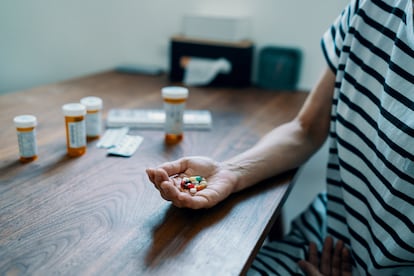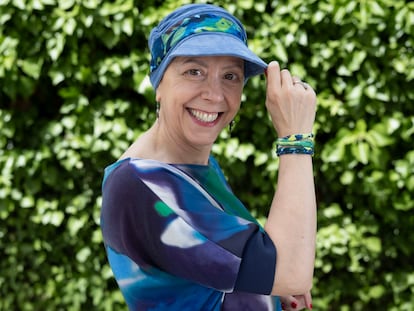Scientists reconstruct structure of the dopamine system to unravel its role in addictions and Parkinson’s disease
Knowing the precise shape of molecules opens the door to designing drugs for dopamine imbalances with fewer side effects

Dopamine is a neurotransmitter with which neurons communicate to perform all kinds of tasks. It is responsible, for example, for motivation or appetite, or that we associate a more intense emotion to learning and thus generate a lasting memory. It is also important for motor function, and when it disappears from some regions of the brain, it can cause Parkinson’s disease. That is why levodopa, which our body metabolizes to make dopamine, is the main treatment for this neurological disease.
Dopamine also explains why the use of drugs such as cocaine produces pleasure by blocking the absorption of the neurotransmitter and keeping its levels elevated in the body. Although dopaminergic neurons make up only 1% of the brain, their influence on our lives is immense and dopamine is one of the most-studied substances.
All of these effects depend on the puzzle-like system that is molecular biology. The structure of a neurotransmitter such as dopamine determines which part of the cells it can fit into and what effect it will have on our organism, from generating sexual desire to pressing the button on the TV remote to watch another episode of a television series.
On August 7, three groups of scientists led by Yan Zhao of the Chinese Academy of Sciences, Eric Gouaux of Oregon Health and Science University (USA), and Claus Loland of the University of Copenhagen (Denmark) published three papers in the journal Nature in which, using electron cryomicroscopy, they show how many molecules bind to the dopamine transporter (DAT). This protein is in charge of recovering dopamine once it has performed its function to maintain the neurotransmitter at normal levels and recycle it for future use.
Cocaine or amphetamines, which modify the motivation and desire of those who take them, achieve their effects by binding to the DAT and preventing it from absorbing dopamine, maintaining high levels in the body and provoking abnormal excitation. However, the molecular puzzle in our body is far from simple. Benztropine, a molecule used to control the tremor of Parkinson’s, has a slightly different structure and slots into a slightly different location in the DAT. “This difference may provide a structural basis as to why therapeutic benztropine [as opposed to cocaine] has no risk of abuse and may have anti-addictive properties,” notes Harald Sitte of the University of Vienna. This offers a starting point for creating medicines that have a therapeutic effect, but do not cause addiction.
Another interesting aspect observed by the researchers is that some molecules modify the structure of other molecules, which complicates the understanding of the puzzle and the use of this knowledge to create molecules that treat some addictions or neurological diseases, but it also introduces new possibilities. Goaux’s team identified a previously unknown lever in the mechanism used by the DAT to collect dopamine from the brain and return it to its storage site. By manipulating that lever with a molecule (MRS7292) that inhibits the DAT, they can modulate its function without interfering with other systems, opening the door to new medical treatments for problems related to dopamine levels, with fewer side effects.
One of the most promising treatments that may emerge from this new knowledge is for cocaine addiction, one of the most widely consumed drugs worldwide and one of the most damaging to health. Effective treatments for cocaine dependence are currently lacking, but “with the knowledge of how cocaine binds to the DAT and inhibits its function, we can prevent this from happening,” explains Loland. “If we prevent cocaine from binding to the DAT, we can create an antidote [for the drug], something that could work in a similar way to how methadone works for heroin addicts,” he concludes.
Sign up for our weekly newsletter to get more English-language news coverage from EL PAÍS USA Edition
Tu suscripción se está usando en otro dispositivo
¿Quieres añadir otro usuario a tu suscripción?
Si continúas leyendo en este dispositivo, no se podrá leer en el otro.
FlechaTu suscripción se está usando en otro dispositivo y solo puedes acceder a EL PAÍS desde un dispositivo a la vez.
Si quieres compartir tu cuenta, cambia tu suscripción a la modalidad Premium, así podrás añadir otro usuario. Cada uno accederá con su propia cuenta de email, lo que os permitirá personalizar vuestra experiencia en EL PAÍS.
¿Tienes una suscripción de empresa? Accede aquí para contratar más cuentas.
En el caso de no saber quién está usando tu cuenta, te recomendamos cambiar tu contraseña aquí.
Si decides continuar compartiendo tu cuenta, este mensaje se mostrará en tu dispositivo y en el de la otra persona que está usando tu cuenta de forma indefinida, afectando a tu experiencia de lectura. Puedes consultar aquí los términos y condiciones de la suscripción digital.
More information
Archived In
Últimas noticias
Aquilino Gonell, former Capitol sergeant: ‘If it hadn’t been for the police, the US would be a dictatorship’
A hybrid building: Soccer pitch, housing, and a shopping mall
Europe urges Trump to respect Greenland following annexation threats
Science seeks keys to human longevity in the genetic mixing of Brazilian supercentenarians
Most viewed
- Alain Aspect, Nobel laureate in physics: ‘Einstein was so smart that he would have had to recognize quantum entanglement’
- Mexico’s missing people crisis casts a shadow over World Cup venue
- Why oil has been at the center of Venezuela-US conflicts for decades
- Alvin Hellerstein, a 92-year-old judge appointed by Bill Clinton, to preside over Maduro’s trial in New York
- Cuba confirms death of 32 of its citizens in the US attack against Venezuela










































